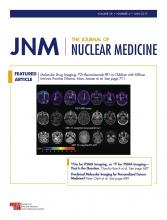Abstract
Predictive tools for guiding therapy in children with brain tumors are urgently needed. In this first molecular drug imaging study in children, we investigated whether bevacizumab can reach tumors in children with diffuse intrinsic pontine glioma (DIPG) by measuring the tumor uptake of 89Zr-labeled bevacizumab by PET. In addition, we evaluated the safety of the procedure in children and determined the optimal time for imaging. Methods: Patients received 89Zr-bevacizumab (0.1 mg/kg; 0.9 MBq/kg) at least 2 wk after completing radiotherapy. Whole-body PET/CT scans were obtained 1, 72, and 144 h after injection. All patients underwent contrast (gadolinium)-enhanced MRI. The biodistribution of 89Zr-bevacizumab was quantified as SUVs. Results: Seven DIPG patients (4 boys; 6–17 y old) were scanned without anesthesia. No adverse events occurred. Five of 7 primary tumors showed focal 89Zr-bevacizumab uptake (SUVs at 144 h after injection were 1.0–6.7), whereas no significant uptake was seen in the healthy brain. In 1 patient, multiple metastases all showed positive PET results. We observed inter- and intratumoral heterogeneity of uptake, and 89Zr-bevacizumab uptake was present predominantly (in 4/5 patients) within MRI contrast-enhanced areas, although 89Zr-bevacizumab uptake in these areas was variable. Tumor targeting results were quantitatively similar at 72 and 144 h after injection, but tumor–to–blood-pool SUV ratios increased with time after injection (P = 0.045). The mean effective dose per patient was 0.9 mSv/MBq (SD, 0.3 mSv/MBq). Conclusion: 89Zr-bevacizumab PET studies are feasible in children with DIPG. The data suggest considerable heterogeneity in drug delivery among patients and within DIPG tumors and a positive, but not 1:1, correlation between MRI contrast enhancement and 89Zr-bevacizumab uptake. The optimal time for scanning is 144 h after injection. Tumor 89Zr-bevacizumab accumulation assessed by PET scanning may help in the selection of patients with the greatest chance of benefit from bevacizumab treatment.
Footnotes
↵* Contributed equally to this work.
Published online Oct. 20, 2016.
- © 2017 by the Society of Nuclear Medicine and Molecular Imaging.







